

International Journal of Agriculture, Environment and Biotechnology
Citation: IJAEB: 13(2): 133-143, June 2020
DOI: 10.30954/0974-1712.02.2020.3
HORTICULTURE
Agrobiodiversity, Composition and Functional Characteristics of Homegardens in Bhimtal Block of Nainital District, Uttarakhand, India
ABSTRACT
Present investigation was carried out to access the agrobiodiversity, composition and functional characteristics of homegardens in bhimtal block of Nainital district, Uttarakhand during 2011-12. The study was carried out in three villages diversified in respect to elevation and agroecological situations viz., Amritpur (520 mts) at low hill, Jeolikote (1219 mts) at mid hill and Ghorakhal (2000 mts) at high hill in Bhimtal block of district Nainital. In these villages a total of 22 respondents of different economic status in each village with a total of 66 respondents were selected and interrogated for the information related to the study. It was found that 80.30 per cent household practicing homegardening and the tree species, fruit tree species (Malus domestica, Citrus sinensis, Psidium guajava), sacred groves species (Ficus roxburghii, Tamarindus indica, Aegle marmelos), timber, fuel wood and fodder tree species (Grevia optiva, Toona ciliata, Mangifera indica, Citrus aurentifolia) were contributed as 33.33, 38.09, 11.90 and 40.74 per cent respectively.
Highlights
 The study was carried out in three villages diversified in respect to elevation and agroecological situations viz., Amritpur (520 mts) at low hill, Jeolikote (1219 mts) at mid hill and Ghorakhal (2000 mts) at high hill in Bhimtal block of district Nainital. In these villages a total of 22 respondents of different economic status in each village with a total of 66 respondents were selected and interrogated for the information related to the study.
The study was carried out in three villages diversified in respect to elevation and agroecological situations viz., Amritpur (520 mts) at low hill, Jeolikote (1219 mts) at mid hill and Ghorakhal (2000 mts) at high hill in Bhimtal block of district Nainital. In these villages a total of 22 respondents of different economic status in each village with a total of 66 respondents were selected and interrogated for the information related to the study.
 It was found that 80.30 per cent household practicing homegardening and the tree species, fruit tree species (Malus domestica, Citrus sinensis, Psidium guajava), sacred groves species (Ficus roxburghii, Tamarindus indica, Aegle marmelos), timber, fuel wood and fodder tree species (Grevia optiva, Toona ciliata, Mangifera indica, Citrus aurentifolia) were contributed as 33.33, 38.09, 11.90 and 40.74 per cent respectively.
It was found that 80.30 per cent household practicing homegardening and the tree species, fruit tree species (Malus domestica, Citrus sinensis, Psidium guajava), sacred groves species (Ficus roxburghii, Tamarindus indica, Aegle marmelos), timber, fuel wood and fodder tree species (Grevia optiva, Toona ciliata, Mangifera indica, Citrus aurentifolia) were contributed as 33.33, 38.09, 11.90 and 40.74 per cent respectively.
Keywords: Homegardens, agrobiodiversity, sacred groves, Bhimtal block, Nainital, Uttarakhand, composition and functional characteristics.
Tropical homegardens is unique multitier agroforestry system with diverse components (trees, shrubs, herbs in association with annual and perennial cultivated plants, along with rearing of livestock, poultry or fish), low input based resource management that meet the diverse requirement of the household which serves as a permanent or temporary (Kumar and Tripathi 2017; Kumar and Tiwari 2020). Compared to other agricultural or horticultural ecosystems, homegardens is very species richness and well suited for ex situ conservation of many rare/endangered species, besides fruit and timber trees (Rana et al. 2016). Agrobiodiversity is a subset of natural biodiversity which includes the plant genetic resources used for food and agriculture (cultivars, landraces, ecotypes, weedy races and wild relatives) (Negri et al. 2009; Kumar and Tiwari 2018). The unique multifunctional sustainability associated with tropical homegardens owes their credit to their credit to their high species richness and evenness (Kehlenbeck et al. 2007). Homegardens structure also varies from place to place according to the local physical environment, ecological characteristics, socioeconomic and cultural factors (Kumar and Nair 2004). Plant community plays a pivotal role in sustainable management by maintaining biodiversity and conserving the environment (Farooquee and Saxena 1996). The knowledge of the floristic composition of a plant community is a prerequisite to understand the overall structure and function of any ecosystem (Suyal et al. 2010).
According to the India State of Forest Report (ISFR) 2017, the total forest and tree cover is 79.42 million hectare, which is 24.39 percent of the total geographical area. Himalayan mountain system covers only 18% of the geographical area of India, but accounts for more than 50% of India’s forest cover and for 40% of the species endemic to the Indian subcontinent. About 45.32% of total geographical area of Uttarakhand is covered with forest (FSI 2015). The most common method of defining agrobiodiversity at the ecosystem level is the species. Although considered ecologically and functional important, there is a lack of information on the agrobiodiversity documentry and their usage of homegardens in Bhimtal block (Amritpur, Jeolikote and Ghorakhal villages) of Nainital district, Uttarakhand.
MATERIALS AND METHODS
The state of Uttarakhand is situated in the northern part of India and shares an international boundary with China in the north and Nepal in the east. It has an area of 53,483km2 and lies between latitude 28°43′ and 31°28′ N and longitude 77°34′ and 81°03′ E. The recorded total forest and tree cover of the State is 24,295km2, which constitutes 45.43 per cent of its geographical area (FSI 2017). The population density of Uttarakhand is 829 persons per sq. km whereas in India the average is 382 persons per sq. km. Nainital district of Uttarakhand is situated between 28°8′ and 29°6′ North latitude and between 78°8′ and 80°14′ East longitude and covering an area of about 4251 square kilometres (Fig. 1).
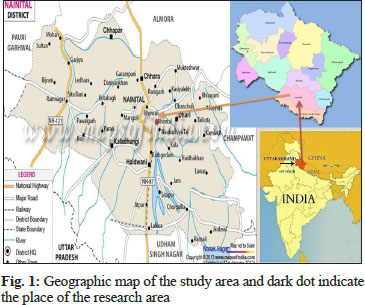
On the basis of geographical conditions, the district is divided into two regions, viz., Bhabhar and hilly area. The Bhabhar is an area that lies between tarai track and foot hills of Shivalik range of Himalaya. The soils in this area are porous and contain a lot of gravels in the soil column. The maximum area of Nainital district is covered by hilly region. This region is manifested with wide agro-climatic variability ranging from sub-tropical to alpine zone. Consequently the climate of the region varies from place to place in accordance with altitudinal variation, slope aspect, density and kind of vegetation. In January, the mean maximum temperature ranges between 9.7° C to 10.2° C and in month of May it varies from 23.5° C to 24.8° C. Annual relative humidity at 830 hours varies from 60-70 per cent. The annual total rainfall is more than 1800 mm, out of which more than 90 per cent precipitation is received from summer monsoon i.e. June to mid-October, eight per cent from the winter cyclone i.e. January-March and the remaining two per cent from the relating monsoon in mid October- December and pre-monsoon showers in April-May. The soils have developed on the rock with biotic and phylitic materials, under cool and moist climate and temperature forest cover. The soils are generally shallow and gravely. Deep soils are confined to hill slopes and valleys. The soils are brown and dark grey in colour and moderately acidic to neutral in reaction. Bhabar soils are shallow with loamy sand with abundant quantities of gravels and stones. Water percolation through profile is very rapid and nutrient and moisture retention capacity and fertility of soil is low (Table 1).
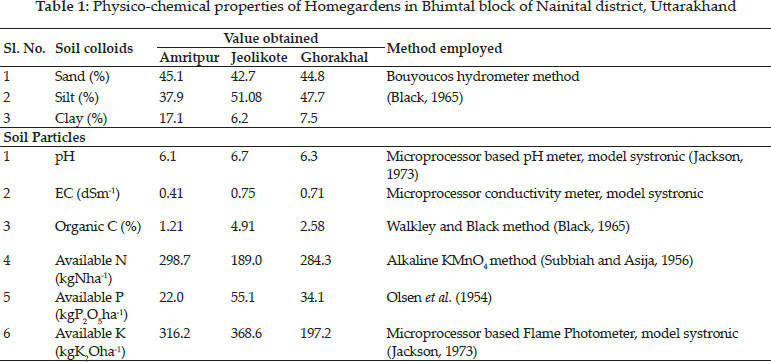
Sampling area: From Nainital district three villages Amritpur, Jeolikote and Ghorakhal of Bhimtal block were selected due to representative sites of the district and on the basis of variation on type of trees species, soil status and how these help in biological diversity. Amritpur village is situated in Nainital Tehsil placed at 520 mts elevation of uttarakhand, which is 217 km away from the Dehradun. Amritpur is surrounded by Haldwani Tehsil towards south, Dhari Tehsil towards west, Nainital and Ramgarh Tehsil towards north. Jeolikote village situated in Nainital Tehsil placed at height of 1219 mts, which located 19 km from kathgodam and 18 km away from Nainital. Ghorakhal village located in Ramgarh Tehsil at Nainital and placed at a height of 2000 mts. It is located 13 km towards east from district Nainital, 206 km from Dehradun. Ghorakhal is surrounded by Bhimtal and Dhari Tehsil towards south, Nainital Tehsil towards west, Almora Tehsil towards north.
Selection of the Respondents: Twenty two families of each village were selected on the basis of land holding capacity, i.e., marginal (<1ha), small (1-2 ha), medium (2-5 ha) and large (>5 ha).
Types of trees species
(i) Name of trees species: It includes type of trees species grown by the farmers, i.e., lemon (Citrus limon), Guava (Psidium guajava), Bhimal (Grewia optiva) etc.
(ii) Numbers of trees species: It includes total number of different trees species grown by farmer on their field.
(iii) Measurements on Tree species: The total number of trees species selected based on four girth class and each class represent four individual species (small, medium, large).
(iv) Frequency of tree species: Frequency of trees species are calculated by the help of dominant trees species prevalent in the given region. Those tree species which are more prevalent have more frequency.
Uses of trees
(a) Fodder and Fuel-wood sources: It refers to types of homegardens trees species, grasses and shrubs are grown traditionally in farmer’s field.
(b) Marketing products.
(c) Forest products: It includes fuel, fodder, fiber, fruit, furniture, timber, medicinal uses etc of various trees in the study area.
(d) Agriculture products: It refers to amount of food grain, vegetable, fruits, livestock product etc which are marketable and sold by farmer to improve its livelihood. It also includes the agency which help in transport and the nearest place distance where farmer sell the products.
(e) Amount of fodder use by livestock: It includes different livestock, viz; buffalo, cow, sheep, bullock and horses and also refers to how much amount of fodders was consumed by different livestock in different seasons.
Data collection for biodiversity conservation: Ethnobotanical data were collected by using semi structured interviews, field observations, ranking and scoring methods. Simple preference ranking was calculated for ten multipurpose tree species in order to assess their number in the study site. Based on their personal preference of efficacy, selected informants were asked to assign their preference to Highest score (1), was assigned to most preferred species was given the lowest score (10). The numbers are summed for all respondents, giving an overall ranking for the items by the selected group of respondents.
Data analysis: The statistical techniques used for data analysis are as follows:
(i) Frequency: It was calculated to find out the number of respondents in a particular cell.
(ii) Percentage: Percentage values were calculated to make simple comparisons. These were calculated by dividing the frequency of a particular cell by the total number of respondents and then multiplying the result by 100.
P = (n / N) * 100
Where, n = frequency of a particular cell and N = total number of respondents
RESULTS AND DISCUSSION
Tropical montane Himalayan forests are characterized by strong gradients related to topography and manifest as differences in elevation, precipitation, humidity, soil type, slope, aspect and radiation (Rana et al. 2016). The predominant tree species planted in the homegardens were Grewia optiva, Ficus roxburghii, Mangifera indica, Quercus leucotrichophora, Citrus limon, Artrocarpus heterophyllus, Adina cordifolia, Aegle marmelos, Psidium guajava, Juglans regia and Morus alba etc. In the present study, in Amritpur village a total of all kind of tree species major contribution i.e. 62.5% was from the Agroforestry trees and the remaining 34.37% was from horticulture tress (Table 2). Similarly, in Jeolikote village the major contribution i.e. 71.42% was from Agroforestry tree species and remaining 35% was from horticulture trees (Table 2). In Ghorakhal village the major contribution i.e. 56.52% was from Agroforestry trees and remaining 43.47% was from the horticulture trees (Table 2). The contribution of agroforestry tree species was more but the magnitude may vary. In Ghorakhal, at higher elevation areas scope of horticulture fruits is more. So there is no scarcity of fodder at higher elevations. The villagers meet their requirement of fodder and fuel wood from the forest area.
Similar study carried out in Bangladesh, 142 plant species were identified out of which 34 species fruit were producing, 24 timbers, 21 fuel wood, 15 medicinal plants, 11 ornamental and 32 vegetable species. Most of the farmers (76%) preferred to plant fruit tree for future plantation followed by timber species (62%). Diversity and abundance of fruit species were found higher in all homesteads (Alam and Masum 2005). In the Mymensingh district of Bangladesh total of 43 woody perennials and 38 vegetable species were found in the study sites. Banana, jackfruit, mango, mahogany, teak, Acacia spp. constituted the major floral composition. The abundance of horticultural species was higher than that of the timber species in all the study sites. However among newly planted homestead plants, timber species were gradually increasing (Muhammed et al. 2011). Recent report indicated that floristic tree diversity was maximum contributed by agroforestry crops (64%, 53.84%, 62.5%, 66.7%) and followed by horticulture crops (36%, 46.16%, 37%, 33.3%) with respect to Malkhi, Khumera, Kurura and Panchan gaun village respectively in homegardens of Garhwal Region, Uttarakhand, India (Rana et al. 2016). The average number of species per garden did not differ significantly among the homegardens categories, but, density and frequency of species increased with decreasing homegardens size. It considered that owners maintain diversity of plants to fulfill their regular needs regardless of the homegardens size. A study in Zambia showed that some products from homegardens, particularly fruit and cabbage were mostly preferred during drought years (Alfred 2009). The earlier studies have also demonstrated that, the aspect had a marked effect on the structure and diversity of forest ecosystems (Kusumlata and Bisht 1991; Das and Das 2005; Sahoo et al. 2010; Devi and Das 2012; Saikia et al. 2012; Kunhamu et al. 2015) had reported that phyto-sociological status was visible among homegardens across the tropics.
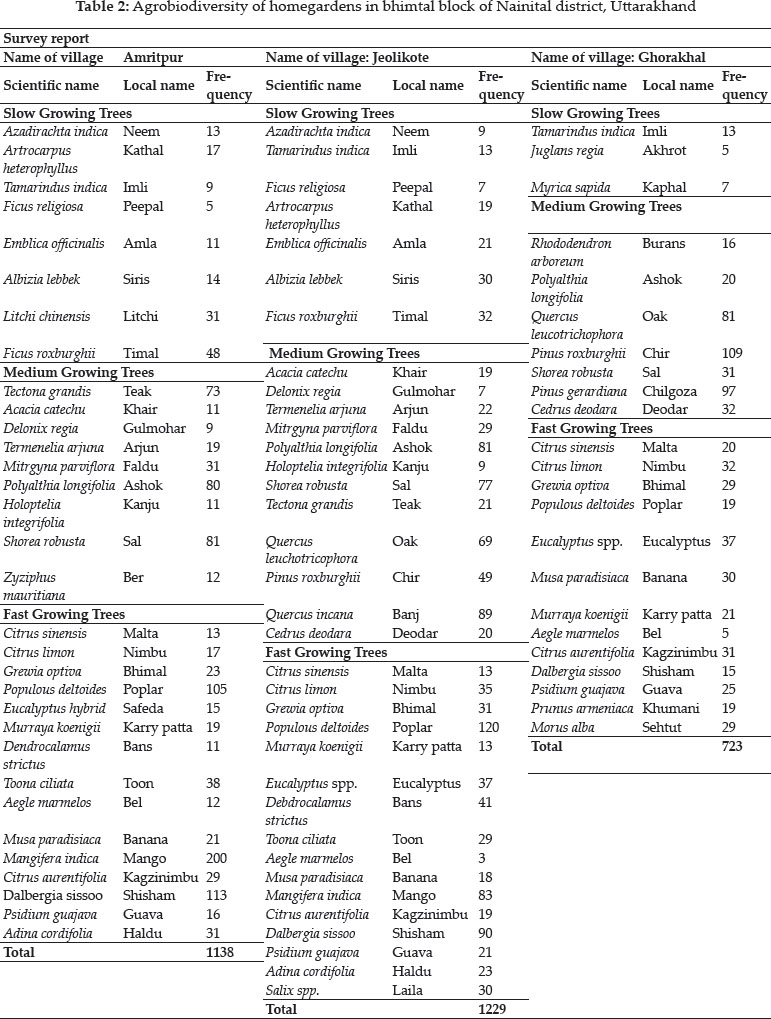
Crops grown in rainfed agriculture in selected Villages: Traditionally agroforestry played a fundamental role in livelihood support for the farmers of Bhimtal block, Nainital, Uttarakhand. Some of the important crops were upland and lowland rice, maize, urd, vegetable pea, amaranthus in kharif. Wheat, mustard, turai, lentil, vegetable peas in rabi. Potato, capsicum, radish, vegetable pea, onion, tomato, turnip, dhania, mirch, ginger, garlic and turmeric (spices) in summer. The area under vegetable was low. The area under horticulture crops and orchards was very less. The orchard were having native cultivars of apple, plum, peach, apricot, mango, lemon, malta, pomegranate with low yield potential (Table 3).

Homegardens along with the useful tree products also provide supplementary crops and vegetables like Tomato (Lycopersicum esculentum), Potato (Solanum tuberosum), vegetable pea (Pisum sativum) etc. It was also reported by Abebe (2005) that integral homegardens not only provide supplementary crops such as fruits and vegetables, but also staple food crops and cash crops. The enset (Enset ventricosum) and coffee (Coffea arabica) in homegarden system in southern Ethiopia was found to be a typical example of integral homegardens. He identified four specific garden types which varied in composition of commercial crop and biodiversity. These variations were related to farm size and access to roads and markets and other socio-economic characters.
Uses of various trees species grown by farmer in the study area: Homegardens agroforestry play an important role for agro-ecosystem service mainly through providing raw material for compost production. Farmer grows trees to fulfill their domestic needs and commercial targets (Table 4). It is worthwhile, that in hilly regions the existence without agroforestry was difficult because trees not only supplement the fodder, fuel, fibre, fruits etc. but also reduces the pace of land sliding in the fields, protect crops to adverse wind and climatic conditions, conserve the moisture, improve the soil quality through nitrogen fixation and organic matter in terms of litter fall etc. The status of natural regeneration of tree crop is very poor in the existing systems due to the deliberate removal of seedlings from the field during cultural and other operations (Saroj and Dadhwal 1997). The Selection of intercrops depends mainly on edapho-climatic conditions of the area, farmer’s need/traditions and resource availability (Bijalwan 2012). The recorded a total of seven primal used categories like fruit, timber, fuel-wood, fencing, religious, ornamental, medicinal and miscellaneous, with fruit trees as a dominant trees species. At least three of all the plant use categories were found in 70% homegardens - fruits, timber and fencing.
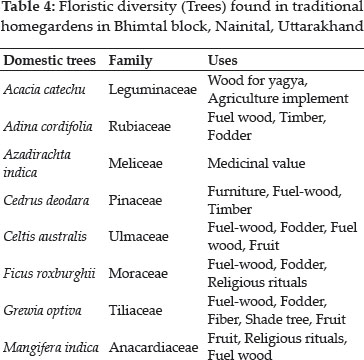
Many of the timber and fruit trees grown in homegardens were also used for fuel-wood purpose. A high percentage of fruit species was linked with multipurpose usage of fruit trees as food, fodder, fuel wood and timber. In the timber category, the most dominant were Quercus leucotrichophora and Cedrus deodara. In addition to providing food, some fruit trees were multipurpose and played an important role during festivals and in rituals. Ficus religosa, Musa paradisiacal and Ficus roxburghii were found to be a common religious plant in all homegardens. Although farmers grew some species like bhimal in the corner for shade management and protection from storms but they did not followed any definite spacing or planting design for species grown, due to lack of technical knowledge.
Fodder and fuel sources: Farmers meet their average daily requirements for animals from agriculture lands and forest area during different seasons of the year (Table 5). The farmers use green as well as dry fodder for their animals. The fuel consumption was much higher by farmer during winter season as compare to summer season. The contribution of homegardens for fodder was 16, 9.5, 8, 6 and 3.5 kg/day for group of buffalo, bullock, cow, horse and goat, respectively (Fig. 1).
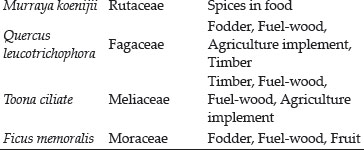
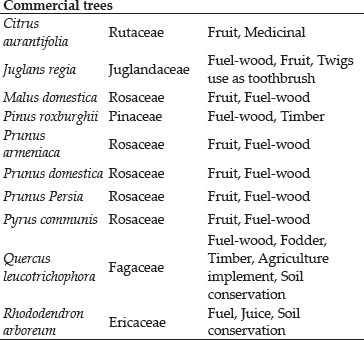
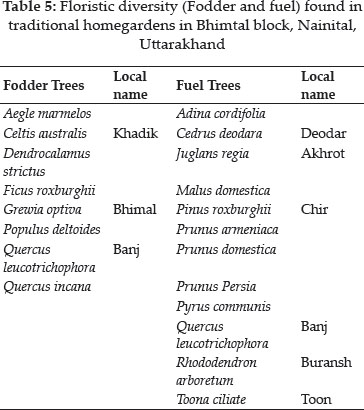
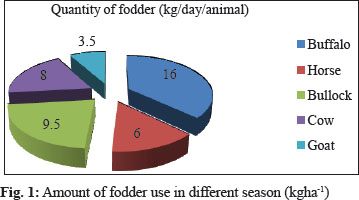
Fuel is the principal energy source for household needs. More time spent by household members to collect fuel wood. To overcome this problem, farmers met the requirement of fuel-wood from their homegardens. In rural villages women’s had to go atleast 12-15 km far in search of fodder for their livestock. So planting fodder trees in the homestead garden reduced their labour. The farmers planted trees mainly to generate income and for the purpose of household consumption in the form of fruit, firewood, and building materials. Toky et al. (1989) reported that the total above ground biomass in agrihorti silvicultural or agri horticultural system was around 48 t/ha and it was about two fold higher than, agrisilviculturtal systems. In fodder tress, significant percentage of annual production up to 48% was allocated in current twigs, while in horticultural trees, a major portion, up to 63% was partitioned in fruits. Trees and shrubs are found ubiquitously, but fodder availability for livestock production is limit.
To access the role of Homegardens in livelihood of the farmer
Homegardening has been a way of life for centuries in the hills and is still important to the local subsistence economy and food security. During the survey of the study area it was found that in small homegardens the food and fruit producing species i.e. 283 trees of Mangifera indica, 84 trees of Citrus limon, 36 trees of Artrocarpus heterophyllus, 34 trees of Musa paradisiaca, 20 trees of Aegle marmelos were dominated near the living houses and working areas, and also the small plots of annual vegetable crops separated the part of the garden from the more distant parts favoured for timber species (Table 6). The homegardens played an important role in the daily livelihood of the farmers. It was noted that the food production was directly increased through edible fruits, nuts, grains etc. From the interview, it was clear that villagers had planted trees in their farms mainly for household consumption and income. Tree species in the homegardens included those supplying food, fuel wood, timber, shade, fencing and medicine. Small farmers were found to use bamboo as their roofing material.
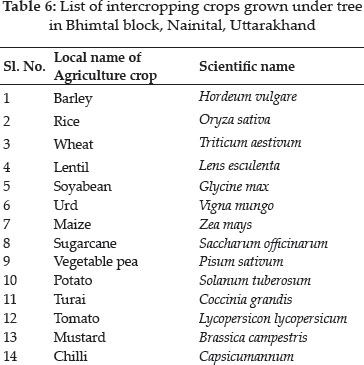
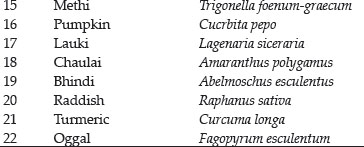
Similarly, only 28% of such products were sold in South African homegardens, the remainder being used for household consumption (High and Shackleton, 2000). The net income generated from homegardens was also correspondingly variable. For example, in Indonesia it ranged from 6.6% to 55.7% of total income with an average of 21.1% depending on the size of the gardens, family needs and species composition (Soemarwoto, 1987). It is estimated that about 50% of the total number of homegardens contribute less than 25% of the total income of the household (Sankar and Chandrashekara 2002). On the other hand, about 32% and 20% of total number of homegardens studied contributed about 25% - 50% and > 50% of the household income respectively. However, the contribution of homegardens for the state economy of wood and bamboo is significant. For instance, according to Krishnankutty (1990) homesteads provide 74% to 84% of wood requirements in Kerala. Recent data recorded that villages the average income per family was found Rs 1000-4000 in the four study sites. Net income generated by farmers from sale of homegardens fruits (Citrus sinensis, Musa paradisiaca, Prunus communis, Prunus armeniaca, Prunus domestica, Citrus aurantifolia) and vegetable include Lycopersicum esculentum, Amaranthus polygamus, Cucurbita pepo) was 6.15% (Rana et al. 2016).
Plant diversity and composition of homegardens in study site: The survey of 66 houses in three villages (Amritpur, Jeolikote, Ghorakhal) of Bhimtal block indicated that 53 (80.30%) households were practicing homegardening. During the study 43 plant species were identified in the region for different uses, i.e. medicinal, aromatic, edible, religious, fodder and fuel wood purposes. Many of these plant species were commonly used by the people of this region for a variety of purposes. With increase in holding size, more diversity variations in species and composition were encountered. Homegardens in the study area were composed of trees, shrubs, herbs, climbers and food crops in different strata. They consisted of trees approximately 10 to 15 m on the upper strata (Eucalyptus, poplar), fruit crops (Prunus persica, Punica granatum, Citrus spp.) encompassed in the middle strata and Herbaceous plants up to 1 m from the ground strata (Beta vulgaris, Brassica oleracea, Daucus carota, Lycopersicum esculentum ).
A total of 43 plant species were documented in the three villages. The highest biodiversity was found in Jeolikote village with 35 species and was identified as the richest homegardens followed by 32 plant species in Amritpur village and 23 plant species in Ghorakhal village, respectively. The highest number of trees was reported in Jeolikote village i.e. 1229 followed by Amritpur village i.e. 1138 and in Ghorakhal 723. Among the recorded species, only 14 species (33.33%) were found in all study sites and 31 (73.80%) species in two homegardens of Amritpur and Jeolikote villages. 22 species were of cultivated crops, 16 (38.09%) were fruit tree species and 5 (11.90%) were religious tree species while timber, fuel wood and fodder tree species were 17 (40.47%) (Table 7).
In the same way a study was done to access the status of biodiversity in Kishoreganj Sadar of northern Bangladesh. A total of 62 plant species including 5 threatened species were identified. The majority of plant species were used as fruit as fodder (45%) followed by medicinal plants (38.71%), fuel wood (32.26%) and timber (29%). Farmers perceived importance for homestead plant species conservation was fruit and food (85%) followed by building materials (78.75%), subsistence family income (73.75%) and (68.75%) as source firewood (Roy et al. 2013). The results of this study indicated that homegardens in these villages had high species diversity and a rich floristic composition that is worthy of in situ conservation of plant biodiversity, and are a source of income from vegetables and other species. In addition, homegardens provide significant contributions for the gardener and the society as source of supplementary food, medicinal functions, and income. A total of 112 plant species belonged to 93 genera and 43 families were identified in Holeta Town, Ethiopia. Out of which, 49 species (43%) were herbs, 32 species (29 %) were trees, 28 species (25 %) were shrubs, and (3%) species were climbers. Further analysis of the results showed that 70 species were cultivated, 35 were wild while 7 species were domesticated. Of the cultivated species, 41.07% were food crops and 58.93% were non-food crops. Family Fabaceae consisted of the highest number of species (11 species), whereas Ensete ventricosum was the most frequently occurring species (93.75%) in the homegardens in Ethiopia (Amberber et al. 2014).
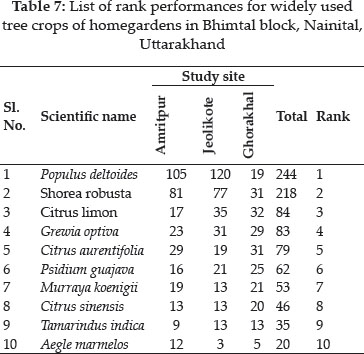
The results of simple preferences ranking in the three study sites showed that Populus spp. was ranked 1st and diversity of Aegle marmelos was ranked lowest. The fruit trees Citrus limon and Psidium guajava were ranked 3rd and 6th.
Factors affecting the homegardens diversity: Homegardeners face a number problems like poor soils, lack of planting material, good infrastructure, transport facilities, inaccessibility of technology, ineffective pest management and improper irrigation facilities in the area. Small and fragmented land holding and low purchase capacity of the farmer also lead to high cost, low return and low income to farmers. Long duration of crops and competition of trees in the same field also cause a lot of problems. Shading effect of planted trees caused low yield of agriculture crop, variation in monsoon, damage of crop due to insect pest, diseases, hailstorm, landslides and other natural calamities affect production. According to the results of semi-structured interviews, the diversity and productivity of homegardens in the study area were mainly affected by lack of agricultural support extension service (83.05%). Disease and pests are the main biological factors of the community sites, which damaged marketable and non- marketable crops.
The same was also found in Holeta Town had high species diversity and a rich floristic composition that is worthy of in situ conservation of plant biodiversity, trial sites of new variety of income source vegetables and other species. In addition, homegardens provide significant contributions for the gardener and the society as source of supplementary food, medicinal functions and income. However, insufficient agricultural support, small sized garden and disease and pests affect the diversity of species. If these challenges receive attention by concerned institutions and researchers, the hotspot will maintain its existing biodiversity and traditional management systems on a sustainable basis in the future (Amberber et al. 2014; Rana et al. 2016).
CONCLUSION
The survey results lead us to conclude that homestead gardens in hills function not only as a dwelling place but as a production system also. Notably, we found that farmers have been motivated to plant trees for multiple purposes, not just for firewood or timber or fodder but the majority of farmers prioritized the financial benefits of trees. The predominant tree species planted in the homegardens were Grewia optiva, Ficus roxburghii, Mangifera indica, Quercus leucotrichophora, Citrus limon etc. The total numbers of trees in Amritpur, Jeolikote and Ghorakhal villages were 1138, 1229 and 723 trees. Highest tree biodiversity was recorded in Jeolikote village and lowest observed in Ghorakhal village. From the survey it was found that the net income generated from the homegardens from the sale fruits (Mangifera indica, Litchi chinensis, Citrus limon, Citrus aurentifolia, Psidium guajava) and vegetables (Lycopersicum esculentum, Amaranthus polygamus, Cucurbita pepo, Abelmoschus esculentus) was 17.39% depending on the size of the gardens. Tree species in the homegardens included those supplying food, cash, fuel wood, timber, shade, fencing and medicine. Small farmers with average income were found to use bamboo as their roofing material. A major finding of the study from the informal interviews with farmers revealed that the economic factors are of primary importance in the decision of whether to plant trees or not. It appeared, therefore, that making tree farming more remunerative is a necessary condition for increasing the amount of tree growing in these homegardens, i.e. to successfully compete with other activities. Adoption of homestead forestry in these areas increased the overall household income. It has also been made clear from the study that farmer’s awareness of forestry extension programs is slight, and the contribution of forestry workers to motivate farmers to grow trees was negligible. To maximize the potential of homestead forestry, forestry professionals and extension workers should broaden their activities and work more closely with local farmers.
REFERENCES
Abebe, T. 2005. Diversity in Homegarden Agroforestry Systems of Southern Ethiopia. Wageningen University, the Netherlands, Tropical Resource Management, pp. 59.
Alam, M.S. and Masum, K.M. 2005. Status of homestead biodiversity in the offshore Island of Bangladesh. Research Journal of Agriculture and Biological Sciences, 1: 246-253.
Alfred, M. 2009. Traditional homegardens and rural livelihood in Nhema, Zimbabwe: a sustainable agroforestry system. International Journal of Sustainable Development World Ecology, 16: 1-8.
Amberber, M., Argaw, M. and Asfaw, Z. 2014. The role of homegardens for in situ conservation of plant biodiversity in Holeta Town, Oromia National Regional State, Ethiopia. International Journal of Biodiversity and Conservation, 6(1): 8-16.
Bijalwan, A. 2012. Structure, Composition and Diversity of Horticulture Trees and Agricultural Crops Productivity under Traditional Agri-Horticulture System in Mid Hill Situation of Garhwal Himalaya, India. American Journal of Plant Sciences, 3: 480-488.
Black, C.A. 1965. Methods of Soil Analysis. Part 2, Agronomy Monograph No. 9, American Society of Agronomy, Madison, Wisconsin, USA, pp. 15-72.
Das, T. and Das, A.K. 2005. Inventorying plant biodiversity in homegardens: A case study in Barak Valley, Assam, North East India. Current Science, 89: 155-163.
Devi, N.L. and Das, A.K. 2012. Diversity and utilization of tree species in Meitei homegardens of Barak valley, Assam. Journal of Environmental Biology, 34: 211-217.
Farooquee, N.A. and Saxena, K.G. 1996. Conservation and utilization of medicinal plants in high hills of the central Himalayas. Environ. Conserv., 23: 75-80.
Forest survey of India (FSI). 2015. The state of forest report, Dehradun, FSI, Ministry of environment and forests, Govt of India, New Delhi, pp. 40.
High, C. and Shackleton, C.M. 2000. The comparative value of wild and domestic plants in homegardens of a South African rural village. Agroforest. Syst., 48: 141-156.
ISFR. 2017. Indian State of Forest Report. Prakash Javadekar, Ministry for Environment, Forest and Climate Change.
Jackson, M.L. 1973. Soil chemical analysis. Prantice Hall of India Pvt. Ltd., New Delhi, India. 186-192, 195-196.
Kehlenbeck, K., Arifin, H.S. and Maass, B. 2007. Plant diversity in homegardens in a socio-economic and agro-ecological context. In: Tscharntke T, Leuschner C, Zeller M, Guhardja E, Bidin A (eds) Stability of Tropical Rainforest Margins, Environmental Science and Engineering. Springer, Berlin, pp. 295-317.
Kumar, B.M. and Nair, P.K.R. 2004. The enigma of tropical homegardens. Agroforestry Systems, 61: 135-152.
Kumar, V. and Tiwari, A. 2020. Importance of Homegardens Agroforestry System in Tropics Region. In book: Biodiversity, Conservation and sustainable Development (Issues & Approaches). Prithwiraj Jha, New Academic Publishers, New Delhi (in press).
Kumar, V. and Tiwari, A. 2018. Importance of tropical homegardens agroforestry system. Int. J. Curr. Microbiol. App. Sci., 6(9): 1002-1019.
Kumar, V. and Tripathi, A.M. 2017. A holistic approach for assessing the vegetation composition and functional changes of tropical homegardens: Prospects and challenges. In: Gupta SK, Panwar P, Kaushal R (eds), Agroforestry for increased production and livelihood security, published in NIPA, New Delhi, pp. 475-505.
Kunhamu, T.K., Ajeesh, R. and Kumar, V. 2015. Floristic analysis of peri-urban homegardens of southern Kerala, India. Indian Journal of Ecology, 42(2): 300-305.
Kusumlata and Bisht, N.S. 1991. Quantitative analysis and regeneration potential of moist temperate forest in Garhwal Himalaya. Indian J. For., 14(2): 98-106.
Muhammed, N., Masum, F.H., Hossain, M., Chakma, S., Oesten, G. and Detten, R.V. 2011. Floral composition and biodiversity conservation in Homestead forests in Mymensingh, Bangladesh. International Journal of Biodiversity Science, Ecosystem Services & Management, 1: 1-11.
Negri, V. 2009. Possible incentives to home garden maintenance: comparing possibilities and raising awareness among farmers. In: Proceedings of a workshop on crop genetic resources in European home gardens. Bioversity International, pp. 72-80.
Olsen, S.R., Cole, C.V., Watanabe, F.S. and Dean, L.A. 1954. Estimation of available phosphorus in soils by extraction with sodium bicarbonate. In: Methods of Soil Analysis. (Black, C.A., Ed). Madison, WIS. American Society of Agronomy, pp. 1044-1046.
Rana, P., Tewari, S.K. and Kumar, V. 2016. Floristic Structure, Composition and Functional Characteristics of Homegardens in Garhwal Region, Uttarakhand, India. International Journal of Agriculture, Environment and Biotechnology, 9(6): 1049-1059.
Roy, B., Rahman, Md. H. and Fardusi, M.J. 2013. Status, Diversity, and Traditional Uses of Homestead Gardens in Northern Bangladesh: A Means of Sustainable Biodiversity Conservation. International Scholarly Research Notices Biodiversity, pp. 1-11.
Sahoo, U.K., Rocky, P., Vanlalhriatpuia, K. and Upadhyaya, K. 2010. Structural diversity and functional dynamism of traditional homegardens of North-East India. The Bioscan., 1: 159-171.
Saikia, P., Choudhury, B.I. and Khan, M.L. 2012. Floristic composition and plant utilization pattern in homegardens of Upper Assam, India. Tropical Ecology, 53: 105-118.
Sankar, S. and Chandrashekara, U.M. 2002. Development and testing of sustainable agroforestry models in different agroclimatic zone of Kerala with emphasis on sociocultural, economic, technical and institutional factors affecting the Sector. KFRI Research Report 234. Kerala Forest Research Institute, Peechi, Kerala.
Saroj, P.L. and Dadhwal, K.S. 1997. Present Status and Future Scope of Mango Based Agroforestry Systems in India. Indian Journal of Soil Conservation, 25(2): 118-127.
Soemarwoto, O. 1987. Homegardens: a traditional agroforestry system with a promising future. In: Steppler H.A. and Nair P.K.R. (eds), Agroforestry: A decade of development, ICRAF, Nairobi, pp. 157-170.
Subbiah, B.V. and Asija, G.L. 1956. A rapid procedure for estimation of available N in soil. Current Science, 25: 259-260.
Suyal, S., Sharma, C.M., Gairola, S., Ghildiyal, S.K., Rana, C.S. and Butola, D.S. 2010. Phytodiversity (Angiosperms and Gymnosperms) in Chaurangikhal forest of Garhwal Himalaya, Uttarakhand, India. Indian Journal of Science and Technology, 3(3): 267-275.
Toky, O.P., Kumar, P. and Khosla, P.K. 1989. Structure and function of traditional Agroforestry Systems in the western Himalaya. I. Biomass and productivity. Agroforestry Systems, 9(1): 47-70.